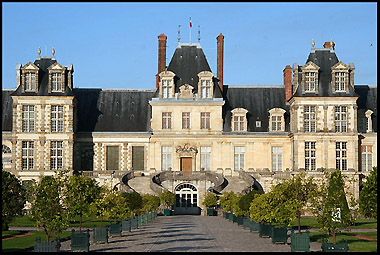 You’ve seen one royal palace, you’ve seen them all, right? Wrong!
You’ve seen one royal palace, you’ve seen them all, right? Wrong!
Although Château Fontainebleau is not as popular as the Palace of Versailles, it is still worth a visit. In fact, some prefer it to Versailles because of its relative informality and its spectacular forest setting.
If you hate crowds and prefer somewhere peaceful, Château Fontainebleau is the perfect royal palace for you since it’s not crowded by tourists. Many visitors come here for horseback riding and hiking, and it’s a perfect spot for an afternoon picnic.
All in all, Château Fontainebleau is a charming place to visit and well worth the trip!
When to Go
Any day but Tuesday. The château is open from 9:30 am to 5:00 pm from October through March. It closes at 6:00 pm from April through September.
Château Fontainebleau is closed on Tuesdays, January 1, May 1, and December 25.
You can see the gardens whenever you’d like – they are open everyday from 9:00 am to 5:00 pm, from November through February. They close at 6:00 pm in March, April, and October. They close at 7:00 pm from May through September. The English garden closes an hour before the other gardens.
The park is open 24 hours a day, 7 days a week.
Cost
Château Fontainebleau is pretty impossible to cover in a day. It’s a good idea to decide what you’d like to see most before you go – you can always see more if you have the time. The Grand Apartments provide a superb introduction to the royal palace.
If you have a Paris Pass, you can get into the monument for free.
A visit to the Large Apartments is €11. This includes the Renaissance Rooms, the Sovereign’s State Apartments, and Napoléon’s Imperial Apartment.
A visit to the Small Apartments and the Napoléon Museum is €6,50.
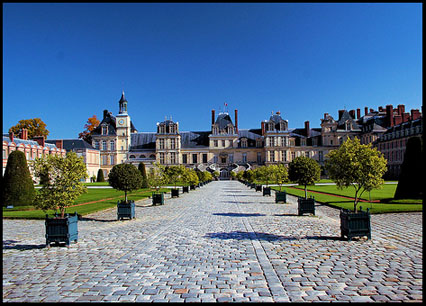
History of Château Fontainebleau
- Fontainebleau has witnessed some monumental historical events, such as the birth of Louis XIII in 1601 and Napoléon signing his deed of abdication there in 1814.
- Château Fontainebleau has attracted great kings since the 12th century due to its proximity to great hunting in the surrounding forest.
- François I converted the hunting lodge into the royal palace during the Renaissance. He employed the cream of the crop of Italy’s artists and craftsmen to decorate the interior, and lay out the gardens with lakes and canals. A century later, the famed Andre le Notre redesigned the gardens.
- Château Fontainebleau was not the product of a single vision. Instead, it is a bewildering cluster of styles from different periods. Various kings made modifications to the château. Louis VII built an abbey here consecrated by Thomas à Beckett in 1169. A medieval tower also survives. Much of the château still dates from the Renaissance, in the days of François I, in which the Renaissance King created a decorative château modeled on Florentine and Roman styles.
- Napoléon called Château Fontainebleau the “house of the centuries” and he refurnished it in 1804. Perhaps there is no moment in its rich history more memorable than when Napoléon stood on the horseshoe shaped exterior staircase and bade farewell to his army before his departure to exile in Elba.
- Set in 50,000 acres of green forest, Fontainebleau remains a country retreat for Parisians.
What to See
- The Courtyard of the White Horse and the horseshoe shaped staircase
- Galerie François I
- The Renaissance Rooms and Ballroom
- Sovereign’s State Apartments
- Napoléon’s Imperial Apartment
- The grounds and gardens
You can enter the château through the stately Cour de Cheval Blanc or Courtyard of the White Horse. It was once a simple enclosed courtyard but was transformed by Napoléon into the main approach to the chateau.
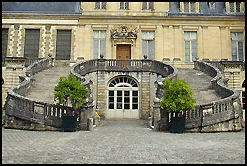 The Horseshoe shaped staircase (Escalier du Fer À Cheval) was built 1634, and lies at the end of the Cour du Cheval Blanc. Its ingenious design allowed carriages to pass beneath the two arches.
The Horseshoe shaped staircase (Escalier du Fer À Cheval) was built 1634, and lies at the end of the Cour du Cheval Blanc. Its ingenious design allowed carriages to pass beneath the two arches.
This staircase is quite famous. Stand at the top and look out over the courtyard and imagine that you are Napoléon. He bade farewell to his Imperial Guard here before being exiled to the island of Elba.
The Galerie François I is a tribute to the Italian artists of the Ecole de Fontainebleau. You can see frescoes painted by Rosso, a pupil of Michelangelo. For years they lay hidden behind other paintings and weren’t rediscovered until the 20th century! Rosso Riorentino’s allegorical frescoes pay homage to the king’s wish to create a second Rome.
The gallery itself is 210 ft long. Quite the spectacle, François I walked the length of the gallery while artisans tried to tempt him with their wares, job seekers asked favors, and courtesans attempted to lure him from the arms of the duchesse d’Etampes.
The gallery is a sight. Stucco-framed panels depict scenes such as Jupiter carrying off Europa, the Nymph of Fontainebleau, and the king holding a pomegranate, the symbol of unity. Like Château de Chambord, the Salamander is everywhere – the symbol of François I.
François I wanted Fontainebleau to be packed with impressive art and this is reflected in the lavish decoration of the Renaissance Rooms.
The highlight of these rooms is the Salle de Bal or the Renaissance Ballroom. The ballroom was designed by Primaticcio in 1552, and was finished under Henri II. His emblem adorns the sunken paneled walnut ceiling, forming a pattern reflected in the parquet floor.
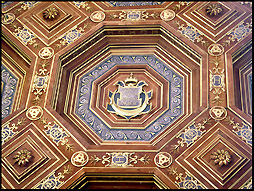
If the rumor is true that François I built Fontainebleau for his mistress, then Henri II, his successor, left a memorial to the woman he loved, Diane de Poitiers. Sometimes referred to as The Gallery of Henri II, the monograms H & D are interlaced in the decorations.
The ballroom is dazzling – it is decorated with wood panels and a series of frescoes painted between 1550 and 1558 that depict mythological and hunting themes. Large windows bathe the room in light and give wonderful views of the grounds outside.
At one end of the room is an enormous fireplace built by Philibert Delorme. It is supported by two bronze satyrs which were reproduced in 1966, since the originals were melted down in the revolution.
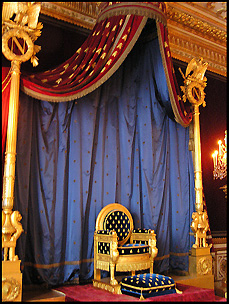 The Sovereign’s State Apartments are even more opulent than the Renaissance Rooms. There is barely an inch of space on the walls or ceilings that has not been decorated. Don’t miss the enormous tapestries in the Tapestry Room and the Salon François I. In the ornate Empress’s Bedchamber sits a bed made for Marie Antoinette, although she never actually used it.
The Sovereign’s State Apartments are even more opulent than the Renaissance Rooms. There is barely an inch of space on the walls or ceilings that has not been decorated. Don’t miss the enormous tapestries in the Tapestry Room and the Salon François I. In the ornate Empress’s Bedchamber sits a bed made for Marie Antoinette, although she never actually used it.
Napoléon converted the former king’s bedchamber into a preposterously extravagant throne room in 1808. The throne is awfully small, don’t you think?
The glory of Fontainebleau was renewed under Napoléon. Napoléon’s Imperial Apartment offers a glimpse into some of the more personal aspects of the emperors life, although this is not his private apartment (the Small Apartments), which can be seen only on a private tour along with Napoléon Museum.
His ceremonial bedchamber is quite lavish, while the Petite Chambre à Coucher de l’Empereur is more humble, with a camp bed. This room also doubled as his study, which you can see by the desk that is present. Look around these rooms for his symbol, the bee.
The Salon Particulier de l’Empereur, now referred to as the Abdication Room, witnessed a key moment in history. The unassuming round table is where Napoléon signed his deed of abdication on April 6, 1814. A copy of the abdication document is on display.
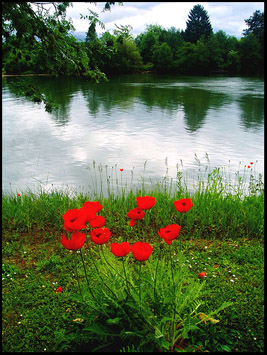 Save time to wander around Fontainebleau’s stunning grounds and gardens. Be sure to visit the elegant Grand Parterre, with its square central pond. Beyond is the 3/4 mi (1.2 km) canal, which was created by Henri IV in 1606. Don’t miss the vast carp pond – in calm weather the reflections on the water are fabulous.
Save time to wander around Fontainebleau’s stunning grounds and gardens. Be sure to visit the elegant Grand Parterre, with its square central pond. Beyond is the 3/4 mi (1.2 km) canal, which was created by Henri IV in 1606. Don’t miss the vast carp pond – in calm weather the reflections on the water are fabulous.
While the gardens are only a prelude to the forest of Fontainebleau, and are not nearly as spectacular as those surrounding Versailles, they still make for a nice afternoon stroll.
The Jardin Anglais, a romantic “English” garden, dating from the 19th century and planted with cyprus and plantain trees. The Jardin de Diane is now more romantic than classical, and features a bronze fountain of Diana as huntress.
For a self-guided walk of the grounds pick up the circuit découverte leaflet at the information desk.